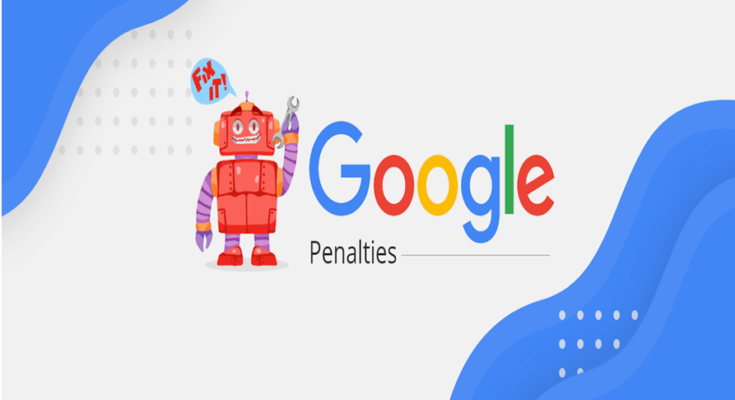The penalties applied as a result of violating the Google Webmaster Guidelines, along with Google algorithms (such as Panda or Penguin), among the main causes of a sudden loss of traffic to Google.
Kaspar Szymanski offers rare information from the perspective of a former Google Search employee with years of experience applying and removing penalties from Google.
Without exception, manual penalties will be applied to sites that are identified as violating the Google Webmaster Guidelines. In other words, penalties are the inevitable consequence of Black Hat techniques applied in an attempt to progress in the SEO strategy.
It does not matter if this happens intentionally due to a coordinated effort as part of a risky trading strategy or if it is simply a supervisory error. When a “Manual Action” message appears in the Google Search Console(GSC), the decision has already been made.
Thereafter, all site development and launch plans are put on hold, as any enhancements introduced while under penalty is a futile effort.
The only priority should be to identify the cause of the penalty, address it, and hopefully request reconsideration. A process that, depending on the size of the problem and the experience of the SEO team, can take days to months.
Step 1. Understand the Problem
Google is honest in communicating its reasons for penalizing a website. The GSC warning message highlights the problem that, in most cases, reduces to an on-page or off-page violation.
In recent years it appears that a large portion of all penalties issued are caused by off-page violations, caused primarily by the construction of bypass links from PageRank.
Obviously, the Black Hat method has some potential for short-term profit, but at the same time it will surely attract Google’s attention and trigger a review over time.
The GSC message refers to “Unnatural Inbound Links”, that is, links that originate from other sites. Most of the time the affected website experiences a sharp decrease in the visibility of Google Search, unless it is completely outside the SERPs.
To recover from this penalty, you will have to start with a complete audit of the backlinks, remove the links and / or reject the links that had become a common thread.
Penalties for Unnatural Backlinks Often Cause a Sharp Decline in Visibility for Google Search.
When it comes to page content breaches, which Google refers to as “Spam Problems” or “Major Spam Problems” (sometimes called Pure Spam), there is a distinction that depends on the severity of the spam problem.
Sites marked as primary spam generally consist of automatically generated or scraping content, often hosted on free hosts and/or disposable domains. In short, they are beyond salvation in their current state.
The operator search in Google Search usually gives 0 results. Any attempt to correct such a site results in building a new site from scratch.
Penalties for Serious or Pure Spam Trigger a Complete Removal of Google Search.
Contrary to these- Google’s opinion after seeing really bad sites- the penalty associated with “Spam Problems” indicates a certain level of decent content, possibly a real brand site that, however, also includes snippets and pieces that are either pages or door pages with very poor content.
Consequently, the affected site falls substantially in Google’s search ranking, but does not completely disappear. Generally, you keep query traffic under your brand name, but you have no way to compete with other sites when it comes to non-brand name queries.
To resolve such problems or if you want to know how to tackle such issues you can visit SEO Community site to get an idea.
The Penalties for Content Spam Cause a Continuous Decrease in the Visibility of Google Search.
However, content spam issues that cause a manual penalty may be due to other reasons. The former does not normally cause a drop in Google Search visibility (in principle).
However, the site is initially labeled as dangerous or compromising in Google’s SERPs, ensuring that most users who see these landing pages clearly marked as potentially dangerous to visit, look for an alternative and less risky outcome.
This warning alone will cause user signals to tell Google that the site is not what users are looking for. Soon after this perception the positioning of the sites will drop dramatically, based on the premise that the site does not live up to user expectations.
If this situation is neglected, although it can be recovered, it will take a long time to regain the trust of users and Google. Sites that are being exploited by users due to insufficient oversight end with a manual penalty of “User Generated Spam”.
For example, “Buy Viagra Here” comments and links, even if they are not clicked or followed, are the type of infringement that causes Google to take action. Forums, Wikipedia-like pages, along with sites that allow unsupervised comments, are most likely to be affected by user spam.
The corresponding manual penalty almost always affects a specific selection of URLs, which end up ranking poorly or not directly. If a website is overloaded with spam, to the point that it is difficult to identify any added value, it will be completely removed from the index.
Dangerous Websites are Labeled with a Warning for the User.
However, another sanction that is frequently applied has no impact on positioning. When Google highlights the detection of “Incorrect Structured Data”, SERPs that previously enjoyed rich snippets are lost. Consequently, the CTR is likely and therefore conversions decrease soon after.
The implementation of structured data can be faulty, not comply with Google standards or be fraudulent. Consequently, stars, reviews, etc. will no longer be displayed in snippets. in Google search results. If you want to get precise and accurate information about Structure data then you can contact an SEO company in your local area such as “Dubai SEO Company”.
Like all other manual penalties, this one can also be lifted, once the matter has been rectified and some “reflection time” has passed, often several months. However, unlike the other manual penalties, there is no certainty that it will return to Google’s “state of grace”.
Once Google has Found the Structured Data to Be Incorrect, the Actual State of the Rich Snippet is Lost.
Few manual penalties used by Google seem to have as slight an impact- often inconspicuous- on a site’s ranking as violating the Guidelines for Webmasters selling bypass links from PageRank.
This also explains why most media websites around the world seem to maintain their visibility in Google Search, despite the sale of links that contain the anchor text that the buyer wants.
It is fair to assume that many of these media outlets are marked with a “Unnatural Outbound Links” warning in their respective Google Search Console accounts.
No manual Google penalty should be ignored, let alone let it continue to be done only because it has not yet had any impact on the core business. After all, penalties can last a long time and can be renewed even when they are expired.
Google is free to change its policies at any time, including changing the scope and impact of penalties, which can further affect sites already penalized.
- Correct your Problem
Solving a manual Google penalty almost always requires two steps: fully focus on the problem outlined in the Google Search Console message and collect enough data to fix the problem.
The penalties applied for building millions of links are more painful, as it takes longer to collect a critical volume of backlink data for risk level assessment. In this situation, the samples provided by the GSC never give a complete picture, so third-party tools such as RYTE should be used .
The server and / or CMS security vulnerability, which leaves the web exposed, has an easy solution, while a complete cleaning of a compromised website also requires the complete removal of all unauthorized spam content.
Penalties imposed for content quality issues, including user-generated spam content, can be resolved just as quickly, but in this case there is no way to avoid auditing the website, including tracking at least a representative portion of the same. So, in this case you must consult digitalmarketing expert.
Finally, a website may be affected by two or more manual penalties, issued to cover different parts of the site for various breaches of the Google Webmaster Guidelines. In that case, each sanction must be addressed individually.
A website can be affected by multiple manual penalties
Step 3. Request a Reconsideration
Almost all manual penalties can be removed after one or two attempts. In addition to this, the justification that must be presented to Google through the Request For Reconsideration is the last crucial step. It is important to note that the Google process is manual.
Experienced Google employees read, review, and research the information provided. Therefore, it is advisable to follow simple guidelines, such as using friendly and brief language. Provide verifiable data.
For example, the volume of backlinks rejected or the number of door pages removed, helps the person sitting on the other side to make a decision quickly.
Finally, committing to following the Google Webmaster Guidelines in the future (and doing it for real) can be an advantage in extreme cases.
Any other information or communication that relates to unrelated issues, such as consideration of taking legal action in the event of refusal or request to turn a blind eye, are not helpful in obtaining approval of a request for reconsideration.
Once the request for reconsideration has been filed, there is nothing that can be done to expedite the process. Creating a new application submission has no effect. Google does not officially commit to a delivery time. Experience indicates that it can take anywhere from several hours to a few weeks.
Checklist
The web has lost positions in Google. Does Google Search Console indicate a manual spam action (aka Google penalty)? If the answer is yes, read the message before investigating further. If it is negative, the cause is probably not related to a penalty.
- Focus on the problem described in Google Search Console and collect the relevant data.
- Document the steps during the process and during the preparation of the request for reconsideration.
- Solve the problem pointed out by Google completely and permanently.
- Request reconsideration with a brief detailed explanation. Provide verifiable numbers.
- Wait for Google’s response after submitting the reconsideration request.
- If they deny the first request for reconsideration, ask for the assistance of an expert.


